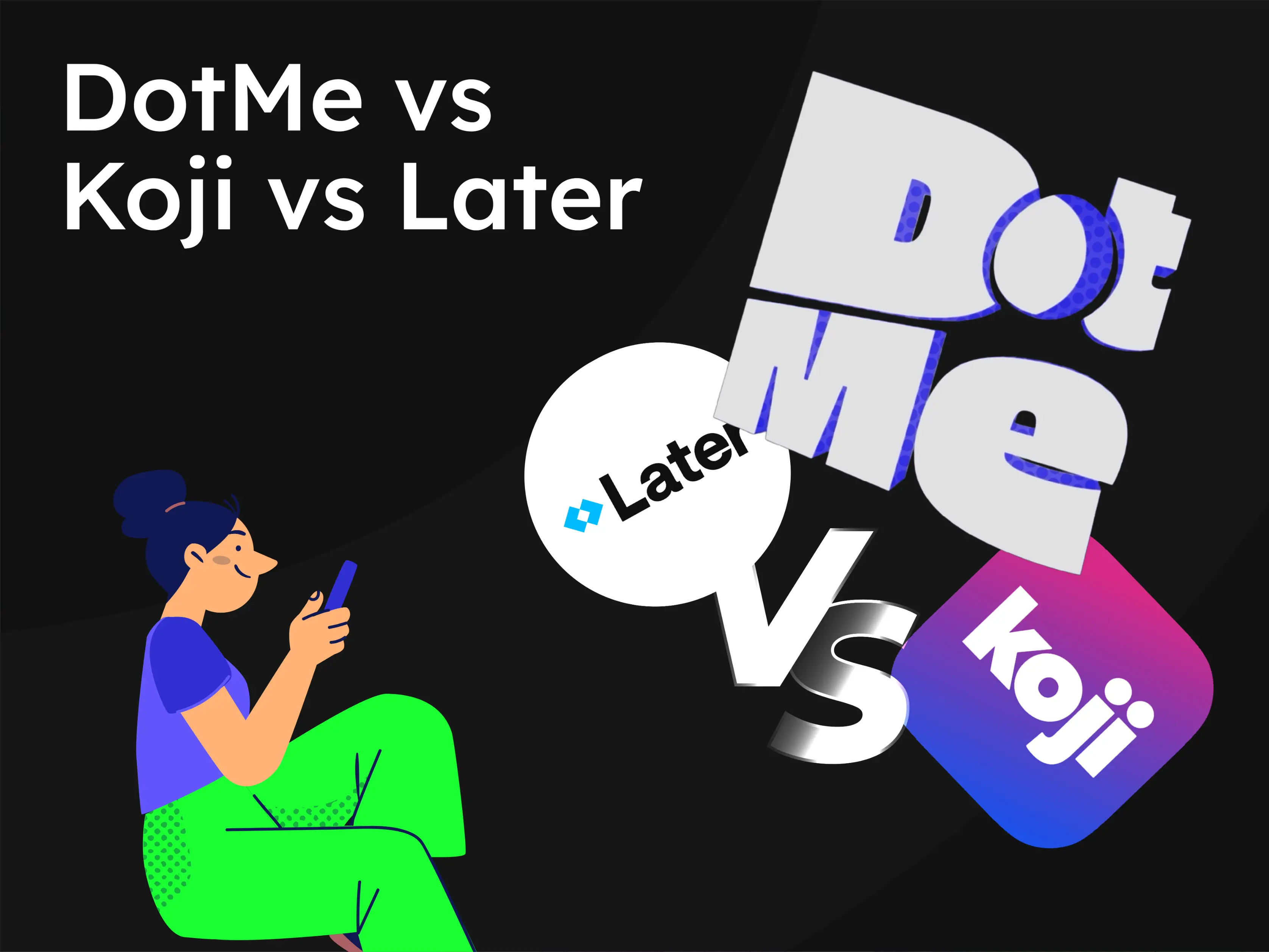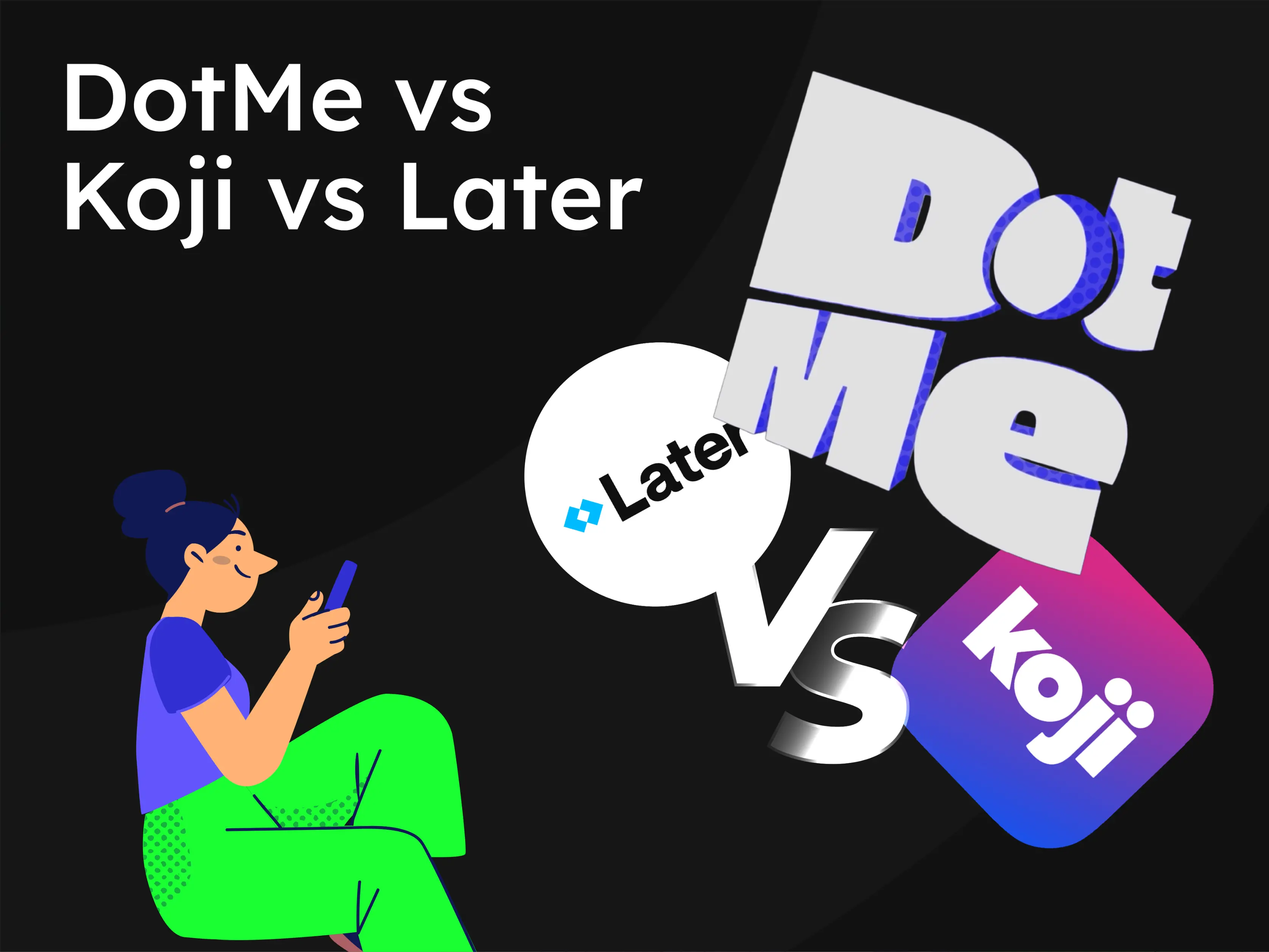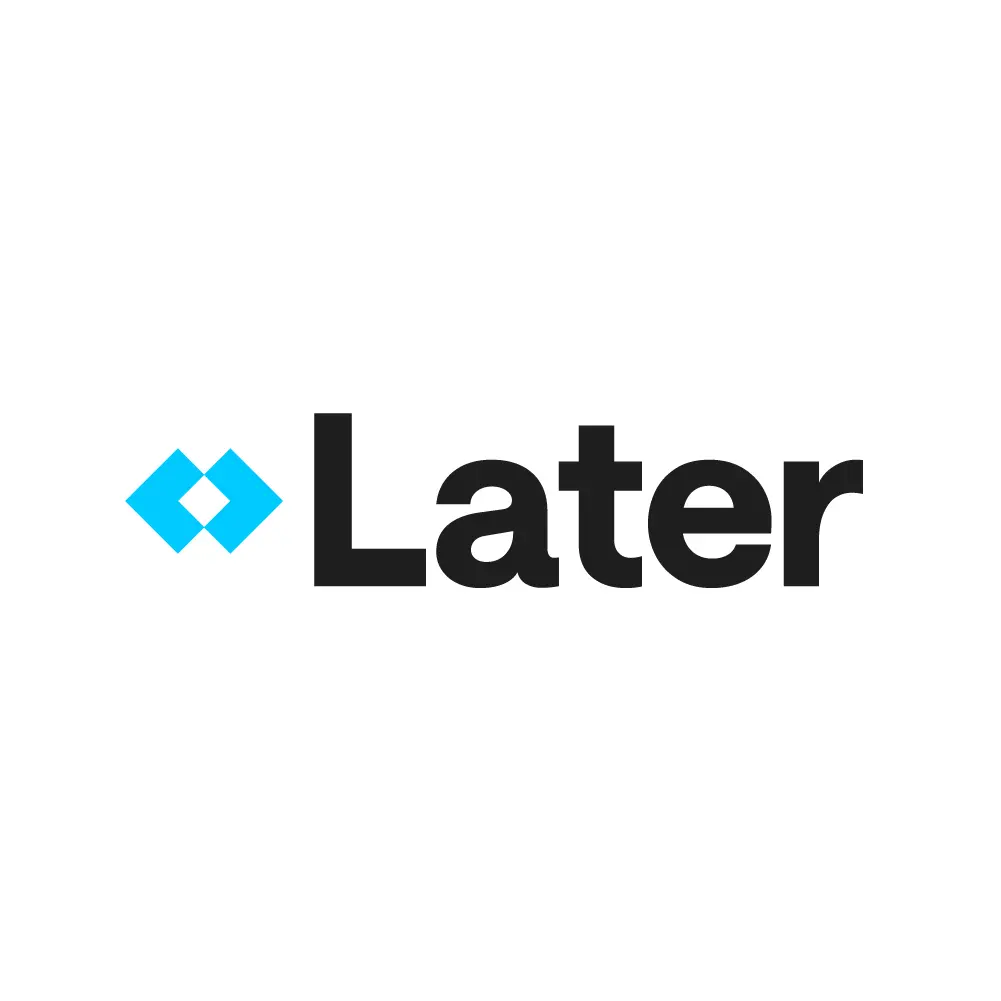
DotMe vs Koji vs Later: Which Link-in-Bio Platform Actually Delivers in 2025?

In 2025, your link-in-bio is more than a directory of links it’s your personal brand’s storefront, content hub, and conversion funnel all rolled into one. And in a world where 5.4 billion people are online and over 60% of traffic comes from mobile, the platform you choose to host that single link can make or break your digital presence.
Link-in-bio tools have evolved fast, from basic link lists to full-featured microsites with embedded e-commerce, analytics, and advanced customization. As the creator economy matures, platforms like DotMe, Koji, and Later are going head-to-head- each promising to help creators monetize smarter, grow faster, and build stronger digital identities.
Koji brings a marketplace-like approach with “mini apps” and creator monetization tools that go beyond links. Later, which began as a social media scheduling platform, now offers Linkin.bio a simple landing page tool focused on Instagram commerce. DotMe, on the other hand, is designed from the ground up to offer full creative control, fast performance, powerful integrations, and direct monetization all while staying intuitive and beautifully designed.
In this blog, we’ll break down how DotMe, Koji, and Later compare across the metrics that matter most: customization, monetization, analytics, performance, pricing, and support so you can decide which link-in-bio platform is actually built for growth in 2025.
DotMe: The Future of Link-in-Bio

DotMe is redefining what a link-in-bio platform can be in 2025. Designed for creators, entrepreneurs, and businesses looking to build a brand-first presence online, DotMe transforms a basic link hub into a fully customizable digital destination. With mobile now accounting for over 60% of global web traffic and the creator economy valued at over $250 billion, having a sleek, high-performing link-in-bio tool isn’t optional it’s essential. DotMe allows users to embed content, showcase digital products, collect payments, and build community without the friction of external tools or platforms.
What sets DotMe apart is its performance and simplicity. The platform delivers fast load times, built-in SEO tools, and real-time analytics all with a drag-and-drop editor that makes setup intuitive for users at any level. It’s one of the few platforms offering zero transaction fees on select plans, making it ideal for monetization. Whether you're selling, sharing, or scaling, DotMe offers a branded, high-converting page that keeps you in control.
Koji: The Monetization-First Micro-App Platform

Koji gained popularity by taking a unique approach to link-in-bio: transforming it into a storefront of interactive mini-apps. Rather than simply linking out to other platforms, Koji lets creators embed tools directly into their profile from tipping jars and eBooks to gated content, Q&As, and product drops. It was built with monetization at its core, making it appealing for creators who wanted to earn revenue directly from their audience, without relying on external marketplaces.
However, Koji’s future is now uncertain. As of early 2024, the platform was officially sunset following its acquisition by Linktree. While some of Koji’s interactive features may be integrated into Linktree’s offerings, the standalone Koji experience no longer exists. For creators exploring options in 2025, this means Koji’s once-innovative model is now part of a broader platform and no longer available as a dedicated, independent tool.
Later: Social-First Simplicity with Linkin.bio

Later started as a social media scheduling tool, but its Linkin.bio feature has evolved into a lightweight link-in-bio solution aimed at Instagram-first creators and brands. It allows users to recreate a clickable version of their Instagram grid, letting each post link to a custom URL. This makes it especially useful for e-commerce brands looking to drive traffic from Instagram to product pages without relying on third-party tools.
While Later offers basic customization like changing colors and fonts to match your brand its link-in-bio tool is more of an add-on than a full-scale platform. It works well if your main focus is Instagram traffic and shoppable posts, but it lacks the deeper monetization, integrations, and content flexibility found in platforms like DotMe. Still, for users already managing their content calendar through Later, Linkin.bio offers a seamless way to connect scheduling with audience engagement.
Feature Comparison
When it comes to choosing the right link-in-bio platform, it’s the features that make all the difference. Let’s break down how DotMe, Koji, and Later compare across key areas like customization, ease of use, monetization, and analytics.
Customization and Branding
DotMe offers strong customization through its drag-and-drop editor, allowing users to tailor layouts, embed rich content like videos and playlists, and add visual elements that reflect their personal brand. While it doesn’t support custom font styles, it gives users enough creative flexibility to build a page that feels premium and unique. Koji focused less on aesthetics and more on functionality, with interactive apps doing most of the heavy lifting. Design was secondary to monetization. Later’s Linkin.bio keeps customization minimal users can change colors and fonts to align with their brand, but the grid-based layout leaves little room for visual creativity beyond the Instagram-first format.
Ease of Use and Setup
All three platforms are user-friendly but in different ways. DotMe makes it easy for anyone to build a beautiful page quickly, with intuitive tools and no learning curve. Koji had a simple app marketplace model users just plugged in mini-apps to activate features though the depth of options could be overwhelming. Later, on the other hand, is extremely easy to use but primarily optimized for users already managing Instagram posts and scheduling content through its dashboard. If you're looking for a standalone link-in-bio solution with more flexibility, DotMe leads in both power and simplicity.
E-Commerce and Monetization
Koji was the most aggressive in this category, offering creators tools to sell digital products, accept tips, and deliver paid content directly from their profile. It treated the bio link as a monetization hub. DotMe, by contrast, offers shoppable links, booking tools, and payment integrations- and critically, zero transaction fees on select plans, making it creator-friendly and scalable. Later’s Linkin.bio is more commerce-adjacent: it enables shoppable Instagram feeds but doesn’t offer deeper monetization features like tipping or digital product sales. It’s designed more for redirecting traffic than transacting directly.
Analytics and Insights
DotMe gives users access to real-time performance data, including clicks, top-performing links, and visitor insights- even on lower-tier plans. This helps creators and businesses make data-driven decisions without needing third-party tools. Koji also offered engagement metrics for its mini-apps, tracking how users interacted with specific modules like games or product pages. Later focuses on social media performance, providing analytics tied to Instagram post clicks and overall profile traffic- useful for social managers, but more limited in scope compared to DotMe’s full-page insights.
Pricing Comparison
Choosing the right platform isn’t just about features- it’s about finding the best value for your money. The right pricing model can determine whether a tool supports your growth or becomes a bottleneck. From creators just starting out to businesses scaling their digital presence, understanding what you’re paying for and what you’re getting- is critical. Here’s how DotMe, Koji, and Later stack up on pricing in 2025.
DotMe Pricing
Dotme offers a transparent pricing model designed to support creators at every stage. The free plan includes unlimited links, basic analytics, and full access to the drag-and-drop builder. Paid plans start at an affordable rate and unlock advanced features like payment integrations, SEO customization, premium embeds, and priority support. Importantly, Dotme doesn’t charge transaction fees on select plans, making it one of the most revenue-friendly platforms for creators who sell directly from their page. With no hidden costs or feature gating, Dotme’s pricing structure is built to scale with your growth.
Koji Pricing
Koji operated on a freemium model with no upfront subscription fees. Instead, it charged transaction fees on sales made through its mini-apps. This made it easy for new creators to get started and only pay when they earned, but it also meant that high-volume sellers would lose a percentage of their revenue over time. As of early 2024, Koji has been sunset following its acquisition by Linktree- so while the pricing model was creator-friendly, it’s no longer available as a standalone option.
Later Pricing
Later’s Linkin.bio tool is available on all plans, including the free tier, but its more advanced features; like additional social sets, deeper analytics, and team access- are only unlocked on paid plans. Pricing is geared more toward users already managing multiple social channels through Later’s scheduling tools. For creators just looking for a link-in-bio platform, the value is somewhat limited unless they’re also using Later for broader social media management. In that sense, Linkin.bio is more of a bonus feature than a standalone offering.
Other Key Factors to Consider
Beyond features and pricing, the best link-in-bio platforms deliver where it counts most: user experience, performance, integrations, and support. Here’s how DotMe, Koji, and Later compare across these critical areas.
User Experience and Interface
DotMe keeps things sleek and simple. Its clean, drag-and-drop editor is intuitive enough for beginners yet flexible enough for advanced users who want a polished, on-brand page without coding. Koji offered a unique modular experience based on its app marketplace- setup was fast, but the UX could feel disjointed depending on which mini-apps you used. Later is built for Instagram-first users and keeps its Linkin.bio interface minimal. It’s easy to navigate but lacks depth for users who want a more immersive or multi-functional page.
Performance and SEO Optimization
Speed and discoverability matter especially when over half of users bounce from pages that take more than 3 seconds to load. DotMe is optimized for fast load times, mobile responsiveness, and SEO customization, including metadata, alt text, and link previews. It gives users control to not just share, but rank. Koji’s app-heavy pages were interactive but could slow down depending on what was loaded. Later’s Linkin.bio is optimized for Instagram and performs well on mobile, but has limited SEO options, since it’s more about driving short-term clicks than long-term visibility.
Integrations and Add-ons
DotMe offers a growing library of integrations, including tools like Mailchimp, Substack, Calendly, and Shopify. You can embed media, add contact forms, and connect external services without code. Koji’s value came from its app store- it integrated features like tip jars, quizzes, games, and storefronts, all natively built. Later integrates closely with social media platforms and e-commerce tools, allowing shoppable feeds, but doesn’t offer broader customization beyond that. For creators who need flexibility and function in one place, DotMe leads on integration depth and ease.
Support and Community
DotMe provides live chat support, a self-serve help center, and onboarding guides for new users- especially helpful for creators launching their first digital hub. Koji offered email-based support and help docs, but community-driven support was limited. Later offers robust support for its full product suite, including Linkin.bio, and has documentation, tutorials, and a responsive help team. That said, many of its resources cater to social scheduling users more than link-in-bio–only users.
Final Verdict: Which Link-in-Bio Platform Wins?
DotMe, Koji, and Later each carved out their own niche in the link-in-bio landscape- but in 2025, the differences couldn’t be clearer. DotMe stands out as the most complete and scalable solution. It combines deep customization, real-time analytics, e-commerce features, and SEO tools- all within a smooth, drag-and-drop experience. With zero transaction fees on select plans and support that grows with your brand, it’s built not just for launching, but for long-term growth. Whether you’re a solo creator, founder, or full-blown brand, Dotme gives you the tools to build something that feels distinctly yours.
Koji was once a standout for its monetization-first mini-app model, but with the platform sunset, it’s no longer a reliable option for creators looking ahead. While some of its functionality may live on through Linktree, the original Koji experience is no longer available.
Later’s Linkin.bio is a useful add-on for users already embedded in its social scheduling ecosystem, especially for brands focused on Instagram commerce. But for creators who want full control over design, monetization, and growth- beyond Instagram- it feels more like a bonus feature than a true standalone platform.
If you’re building a serious digital presence in 2025, Dotme isn’t just the better tool it’s the smarter long-term bet.
FAQs
Is DotMe better than Later for creators?
Yes. While Later’s Linkin.bio is great for Instagram commerce, DotMe offers more advanced built-in monetization tools, SEO controls, and real-time analytics- making it a stronger option for creators who want full ownership over their online presence.
What happened to Koji?
Koji was officially sunset in early 2024 following its acquisition by Linktree. While some of its interactive features may be absorbed elsewhere, the standalone Koji platform is no longer active or available as a link-in-bio tool in 2025.
Which link-in-bio tool offers the best value?
DotMe offers one of the most competitive pricing models in the space, including a robust free plan and affordable upgrades with no hidden fees. It’s ideal for creators, entrepreneurs, and brands who want professional-grade features without premium pricing.
